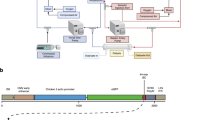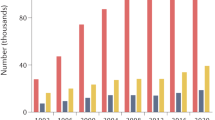Abstract
The immune response of liver transplant recipients was modulated via adenovirus-mediated transduction of the cold-preserved liver with sequences encoding CTLA4lg. Transplanted allografts demonstrated rapid transient local expression and recombinant protein production shortly after revascularization, resulting in intact liver function, indefinite survival of the recipient, and the development of donor-specific unresponsiveness. Lymphocytic infiltration of the graft was mainly of the T helper 2 (Th2) subset and was not associated with injury to primary cellular targets of the alloimmune response. These findings demonstrate a successful outcome of a feasible and potentially clinically relevant system of gene delivery of sequences encoding proteins capable of inhibiting the alloimmune response.
This is a preview of subscription content, access via your institution
Access options
Subscribe to this journal
Receive 12 print issues and online access
$209.00 per year
only $17.42 per issue
Buy this article
- Purchase on Springer Link
- Instant access to full article PDF
Prices may be subject to local taxes which are calculated during checkout
Similar content being viewed by others
References
Grusby, M.J. et al. Mice lacking major histocompatibility complex class I and class II molecules. Proc Natl. Acad. Sci. USA 90, 3913–3917 (1993).
Auchincloss, J. Jr., et al. The role of “indirect” recognition in initiating rejection of skin grafts from major histocompatibility complex class II-deficient mice. Proc. Natl. Acad. Sci. USA 90, 3373–3377 (1993).
Cozzi, D. & White, D.J. The generation of transgenic pigs as potential organ donors for humans. Nature Med. 1, 964–966 (1995).
Byrne, G.W. et al. Transgenic pigs expressing human CD59 and decay-accelerating factor produce an intrinsic barrier to complement-mediated damage. Transplantation 63,149–155 (1997).
Snaked, A. et al. Adenovirus-mediated gene transfer in the transplant setting II: Successful expression of transferred cDNA in syngeneic liver grafts. Transplantation 57, 1508–1511 (1994).
Drazan, K.E., et al. In vivo adenoviral-mediated human p53 tumor suppressor gene transfer and expression in rat liver after resection. Surgery 116, 197–204 (1994).
Drazan, K.E., Chen, X.D., Busuttil, R.W., Csete, M. & Shaked, A. Gene transfer in the transplant setting III: Variables affecting recombinant gene expression in liver grafts. Transplantation 59, 670–673 (1995).
Drazan, K.E. et al. Hepatic liver function is preserved after adenoviral-mediated gene transfer. J.Surg.Res. 59, 299–304 (1995).
Lin, H. et al. Long-term acceptance of major histocompatibility complex mismatched cardiac allograft induced by CTLA4lg plus donor-specific transfusion. J. Exp. Med. 178, 1801–1806 (1993).
Baliga, P. et al. CTLA4lg prolongs allograft survival while suppressing cell-mediated immunity. Transplantation 58, 1082–1090 (1994).
Lenschow, D.J. et al. Long-term survival of xenogeneic pancreatic islet grafts induced by CTLA4Ig. Science 257, 789–792 (1992).
Wang, J. jiano, S., Wolff, J.A., & Knechtle, S.J. Gene transfer and expression in rat cardiac transplant. Transplantation 53, 703–705 (1992).
Shaked, A. et al. Retroviral-mediated gene transfer into rat experimental liver transplant. Transplantation 57, 32–32 (1994).
Csete, M.E. et al. Adenovirus-mediated gene transfer in the transplant setting. I. Conditions for expression of transferred gene in cold preserved hepatocytes. Transplantation 57, 1502–1507 (1994).
Tripathy, S.K., Black, H.B., Goldwasser, E. & Leiden, J.M. Immune responses to transgene-encoded proteins limit the stability of gene expression after injection of replication-defective adenovirus vectors. Nature Med. 2, 545–550 (1996).
Yang, Y., Su, Q. & Wilson, J.M. Role of viral antigens in destructive cellular immune responses to adenovirus vector-transduced cells in mouse lungs. J. Virol. 70, 7209–7212(1996).
Yang, Y., Jooss, K.U., Su, Q., Ertl, H.C. & Wilson, J.M. Immune responses to viral antigens versus transgene product in the elimination of recombinant adenovirus-infected hepatocytes in vivo. Gene Ther. 3,137–144 (1996).
Linsley, P.S. et al. Immunosuppression in vivo by a soluble form of the CTLA-4 T cell activation molecule. Science 257, 792–795 (1992).
Sayegh, M.H., et al. CD28-B7 blockade after alloantigenic challenge in vivo inhibits Thi cytokines but spares Th2. J. Exp. Med. 181, 1869–1874 (1995).
Judge, T.A., et al. The in vivo mechanisms of action of CTLA4Ig. J. Immunol. 156, 2294–2299 (1996).
Kamada, N. & Calne, R.Y. Orthotopic liver transplantation in the rat: Technique using cuff for portal vein anastomosis and biliary drainage. Transplantation 28, 47 (1979).
Lin, H., lammattoni, M.D., Modblum, J.R., & Boiling, S.F. Experimental hetero-topic heart transplantation without ischemia or reperfusion. J. Heart Transplant.9,720(1990).
Hirt, J.M.B. Selective extraction of polyoma DNA from infected mouse cell cultures. J. Mol. Biol. 26, 365–369 (1967).
Graham, F.L. & van der Eb A.J. A new technique for the assay of infectivity of human adenovirus 5 DNA. Virology 52 2(2)456–467 (1973).
Hancock, W.W. et al. Costimulatory function and expression of CD40-ligand, CD80 and CD86 in vascularized murine cardiac allograft rejection. Proc. Natl. Acad. Sci. USA 93, 13967–13972 (1996).
Author information
Authors and Affiliations
Corresponding author
Rights and permissions
About this article
Cite this article
Olthoff, K., Judge, T., Gelman, A. et al. Adenovirus-mediated gene transfer into cold-preserved liver allografts: Survival pattern and unresponsiveness following transduction with CTLA4Ig. Nat Med 4, 194–200 (1998). https://doi.org/10.1038/nm0298-194
Received:
Accepted:
Issue Date:
DOI: https://doi.org/10.1038/nm0298-194
This article is cited by
-
Genetic Heterogeneity and Efficiency of Two Different Methods of Adenovirus-Mediated Gene Transfer in a Rat Liver Transplantation Model
Surgery Today (2006)
-
A preclinical model of hepatocyte gene transfer: the in vivo, in situ perfused rat liver
Gene Therapy (2000)
-
Gene therapy in transplantation in the year 2000: moving towards clinical applications?
Gene Therapy (2000)
-
Gene therapy in transplantation
Gene Therapy (1999)



